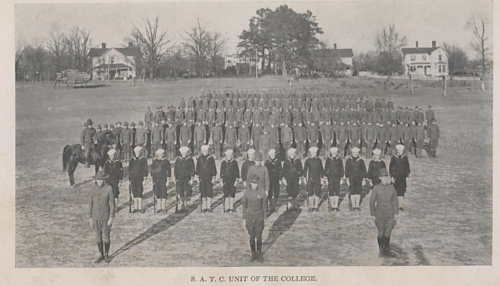
This blog post was written by SCA student employee Katie Lawrence.
This year looks very different than we’re used to in the Forest. Most classes are online, masks are required, and the campus feels different than it has in the past. COVID-19 has turned this semester upside down, but Wake students have persisted in the spirit of Pro Humanitate. Our continued presence here is a testament to that effort. However, this isn’t the first time Wake Forest students have been on campus in the midst of a pandemic.
In the Fall of 1918, the Spanish Flu was beginning its second, and deadliest, wave in the United States. This strain of influenza was first reported in the U.S. in the Spring of 1918 among military personnel in Kansas, and spread across the country from there (source). Its name suggests that it originated in Spain, but that is not the case; the origins of the virus are still unknown. Americans took to calling it the Spanish Flu because most of the reports of sickness were coming out of Spain, so they assumed it originated there. However, this is because the Spanish media, unlike the media of the countries involved in World War I, was not censored and able to broadcast about public health freely. Allied and Central Powers avoided media broadcasts about the influenza pandemic in order to avoid lowering morale (source).
Despite the influenza ravaging the east coast, students returned to campus, hopeful, as we are today, that learning and camaraderie could still take place. Interestingly, neither The Howler yearbook nor the Old Gold and Black mentioned the Spanish Flu explicitly. Exhaustive research turned up a few mentions in The Student, Wake Forest’s literary magazine. One such mention, from the February 1919 edition stated, “Much credit is due the professors of medicine of the college . . . for the remarkable and skillful way in which they managed the influenza situation. There has only been one death in the college. And likely it was due only indirectly to influenza” (p. 36). This made me wonder – was the Spanish Flu not prevalent at Wake Forest? Was the campus not significantly impacted? How could this pandemic not have earned space in any of the major university publications when it was tearing cities apart up and down the east coast?
The answer: World War I. Wake Forest essentially turned its campus into a military training ground during the fall of 1918, and this was the current event that was at the forefront of every student’s mind. The Old Gold and Black was not in operation throughout the fall of 1918, and we learn from The Howler (published in Spring 1919) that “the first term [Fall 1918] was marked by no special events in college life, for the S.A.T.C. [Student’s Army Training Corps] was the dominating phase of our fall work” (p. 78). The quote above was cited from the Sophomore Class History section of the yearbook, and the Freshman Class History segment told a similar story. They state, “The Class of ‘22 entered Wake Forest under different conditions from its predecessors. It was introduced to a combination of college life and army regime, so the Freshman class did not . . . become acquainted with the real Wake Forest until the Spring term” (p. 83). The February 1919 edition of The Student also printed a whole essay dedicated to describing life as a Wake Forest student and member of the S.A.T.C. in the Fall of 1918. Essentially, the students had time for work, sleep, and little else. Their minds were constantly focused on the war, and they were training, studying, and living like they were soldiers in it. This preoccupation helps to make sense of the lack of information about the Spanish Flu during this time. If students were drilling 24/7, then the influenza was either not present on campus to a significant extent or just not prominent enough to mention. Although I’m still scratching my head as to why it received no more than a few blurbs, the greater global context and role of Wake Forest at the time helps to put this into perspective.
[A note: The research done for this blog post was limited to digitized collections due to the current Covid-19 restrictions on in-person research in Special Collections & Archives. This is not an exhaustive scan of all archival materials available in the University Archives on this topic, but rather a glimpse at digitized student publications from the time.]
12 Comments on ‘Wake Forest College and The Spanish Flu’
Thanks for this timely and well-researched post. I enjoyed reading it.
Excellent post! It certainly is surprising that the Spanish Flu isn’t better documented in Wake’s records. Thank you, Katie, for your research and this historical context!
Thank you, Katie, for researching this topic and for writing an excellent blog post!
Katie, this is a fascinating post – thank you! Like many, I’ve wondered how Wake Forest responded to the Spanish Flu and now I know.
Congratulations for this informative report regarding Wake Forest College and the Spanish Flu.
Thanks for having explored this. I read an article in Smithsonian Magazine about the 1918 pandemic back in 2017. It struck me then and does even more so now: https://www.smithsonianmag.com/history/journal-plague-year-180965222/
I’m as puzzled as you at the lack of documents. It sure would be interesting if any family letters from that time that individuals may have stored away in shoeboxes would shed any more light on the Spanish Flu at Wake Forest College!
Great read! Appreciate the in-depth research on this bit of WF history. ZSR SC&A does it again!
This is really a fascinating look into both how the pandemic of 1918-19 affected campus, and how our documents tell us the story of that time. Thanks for this insightful look!
Thank you for the look back into history and life at WFU during the Spanish Influenza Katie! Who knew that 100 years later . . .
Very cool to take a look back, thank you for going deep into the digitized archives Katie!!
In the 2nd paragraph, you mistakenly put 2018 instead of 1918. Enjoyed the article.
Thank you! We corrected that.